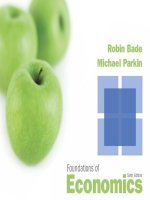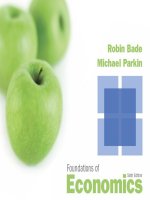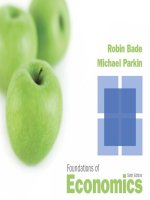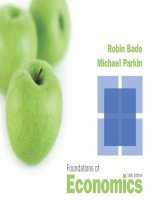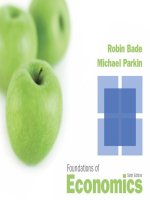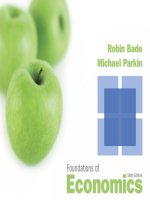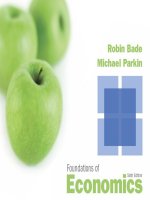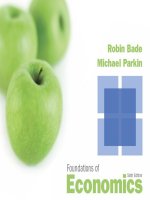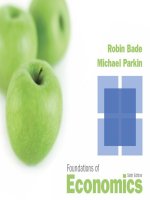Foundaions of economics 6th by robin bade ch06
Bạn đang xem bản rút gọn của tài liệu. Xem và tải ngay bản đầy đủ của tài liệu tại đây (1.23 MB, 69 trang )
© 2013 Pearson
Should price gouging be illegal?
© 2013 Pearson
6
Efficiency and Fairness
of Markets
CHAPTER CHECKLIST
When you have completed your
study of this chapter, you will be able to
1 Describe the alternative methods of allocating scare
resources and define and explain the features of an efficient
allocation.
2 Distinguish between value and price and define consumer
surplus.
3 Distinguish between cost and price and define producer
surplus.
© 2013 Pearson
When you have completed your
study of this chapter, you will be able to
4 Evaluate the efficiency of the alternative methods of
allocating scare resources.
5 Explain the main ideas about fairness and evaluate the
fairness of alternative methods of allocating scarce
resources.
© 2013 Pearson
6.1 ALLOCATION METHODS AND EFFICIENCY
Resource Allocation Methods
Scare resources might be allocated by
•
•
•
•
•
•
•
•
•
Market price
Command
Majority rule
Contest
First-come, first-served
Sharing equally
Lottery
Personal characteristics
Force
How does each method work?
© 2013 Pearson
6.1 ALLOCATION METHODS AND EFFICIENCY
Market Price
When a market allocates a scarce resource, the people
who get the resource are those who are willing to pay the
market price.
Most of the scarce resources that you supply get
allocated by market price.
You sell your labor services in a market, and you buy
most of what you consume in markets.
For most goods and services, the market turns out to do
a good job.
© 2013 Pearson
6.1 ALLOCATION METHODS AND EFFICIENCY
Command
Command system allocates resources by the order
(command) of someone in authority.
For example, if you have a job, most likely someone
tells you what to do. Your labor time is allocated to
specific tasks by command.
A command system works well in organizations with
clear lines of authority but badly in an entire economy.
© 2013 Pearson
6.1 ALLOCATION METHODS AND EFFICIENCY
Majority Rule
Majority rule allocates resources in the way that a
majority of voters choose.
Societies use majority rule for decisions about tax rates
that allocate resources between private and public use
and tax dollars between competing uses such as
defense and health care.
Majority rule works well when the decision affects lots of
people and self-interest must be suppressed to use
resources efficiently.
© 2013 Pearson
6.1 ALLOCATION METHODS AND EFFICIENCY
Contest
A contest allocates resources to a winner (or group of
winners).
The most obvious contests are sporting events but they
occur in other arenas:
For example, The Oscars are a type of contest.
Contest works well when the efforts of the “players” are
hard to monitor and reward directly.
© 2013 Pearson
6.1 ALLOCATION METHODS AND EFFICIENCY
First-Come, First-Served
A first-come, first-served allocates resources to those
who are first in line.
Casual restaurants use first-come, first served to
allocate tables. Supermarkets use first-come, firstserved at checkout. Airlines use first-come, first-served
to allocate standby seats.
First-come, first-served works best when scarce
resources can serve just one person at a time in a
sequence.
© 2013 Pearson
6.1 ALLOCATION METHODS AND EFFICIENCY
Sharing Equally
When a resource is shared equally, everyone gets the
same amount of it.
You might use this method to share a dessert in a
restaurant.
To make sharing equally work, people must be in
agreement about its use and implementation.
It works best for small groups who share common goals
and ideals.
© 2013 Pearson
6.1 ALLOCATION METHODS AND EFFICIENCY
Lottery
Lotteries allocate resources to those with the winning
number, draw the lucky cards, or come up lucky.
State lotteries and casinos reallocate millions of dollars
worth of goods and services each year, but lotteries are
more widespread.
For example, tickets to Michael Jackson’s memorial
service were allocated by lottery.
Lotteries work well when there is no effective way to
distinguish among potential users of a scarce resource.
© 2013 Pearson
6.1 ALLOCATION METHODS AND EFFICIENCY
Personal Characteristics
Personal characteristics allocate resources to those with
the “right” characteristics.
For example, people choose marriage partners on the
basis of personal characteristics.
But this method gets used in unacceptable ways:
allocating the best jobs to white males and
discriminating against minorities and women.
© 2013 Pearson
6.1 ALLOCATION METHODS AND EFFICIENCY
Force
Force plays a role in allocating resources.
For example, war has played an enormous role
historically in allocating resources.
Theft, taking property of others without their consent,
also plays a large role.
But force provides an effective way of allocating
resources—for the state to transfer wealth from the rich
to the poor and establish the legal framework in which
voluntary exchange can take place in markets.
© 2013 Pearson
6.1 ALLOCATION METHODS AND EFFICIENCY
Using Resources Efficiently
Allocative efficiency is a situation in which the quantities of goods
and services produced are those that people value most highly.
It is not possible to produce more of one good or service without
producing less of something else.
Efficiency and the PPF
• Production efficiency—producing on PPF
• Producing at the highest-valued point on PPF
The PPF tells us what can be produced, but the PPF does not tell us
about the value of what we produce.
© 2013 Pearson
6.1 ALLOCATION METHODS AND EFFICIENCY
Marginal Benefit
Marginal benefit is the benefit that a person receives
from consuming one more unit of a good or service.
People’s preferences determine marginal benefit.
The marginal benefit from a good is what people are
willing to forgo to get one more unit of the good.
Marginal benefit decreases as the quantity of the good
increases—the principle of decreasing marginal benefit.
© 2013 Pearson
6.1 ALLOCATION METHODS AND EFFICIENCY
Possibility A and point
A tell us that if we
produce 2,000 pizzas
a day,
people are willing to
give up 15 units of
other goods and
services up to get one
more pizza.
© 2013 Pearson
6.1 ALLOCATION METHODS AND EFFICIENCY
Point B tells us that if
we produce 4,000
pizzas a day,
people are willing to
give up 10 units of
other goods and
services to get one
more pizza.
© 2013 Pearson
6.1 ALLOCATION METHODS AND EFFICIENCY
Point C tells us that if
we produce 6,000
pizzas a day,
people are willing to
give up 5 units of other
goods and services to
get one more pizza.
The line through points
A, B, and C is the
marginal benefit curve.
© 2013 Pearson
6.1 ALLOCATION METHODS AND EFFICIENCY
Marginal Cost
Marginal cost is the opportunity cost of producing one
more unit of a good or service and is measured by the
slope of the PPF.
The marginal cost of producing a good increases as
more of the good is produced.
The marginal cost curve shows the amount of other
goods and services that we must give up to produce
one more pizza.
© 2013 Pearson
6.1 ALLOCATION METHODS AND EFFICIENCY
Possibility A and point
A tell us that if we
produce 2,000 pizzas
a day,
we must give up 5
units of other goods
and services to
produce one more
pizza.
© 2013 Pearson
6.1 ALLOCATION METHODS AND EFFICIENCY
Point B tells us that if
we produce 4,000
pizzas a day,
we must give up 10
units of other goods
and services to
produce one more
pizza.
© 2013 Pearson
6.1 ALLOCATION METHODS AND EFFICIENCY
Point C tells us that if
we produce 6,000
pizzas a day,
we must give up 15
units of other goods and
services to produce one
more pizza.
The line through points
A, B, and C is the
marginal cost curve.
© 2013 Pearson
6.1 ALLOCATION METHODS AND EFFICIENCY
Efficient Allocation
The efficient allocation is the highest-valued allocation.
That is, the allocation is efficient if it is not possible to
produce more of any good without producing less of
something else that is valued more highly.
To find the efficient allocation, we compare marginal
benefit and marginal cost.
Figure 6.3 on the next slide shows the efficient quantity
of pizzas.
© 2013 Pearson
6.1 ALLOCATION METHODS AND EFFICIENCY
Production efficiency occurs at
all points on the PPF.
Allocative efficiency occurs at
the intersection of the marginal
benefit curve (MB) and the
marginal cost curve (MC).
Allocative efficiency occurs at
only one point on the PPF.
© 2013 Pearson
